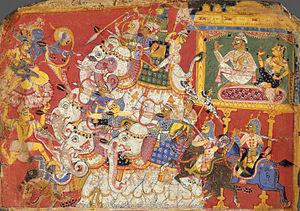Deepavali or Diwali[note 1], p
opularly known as the "festival of lights," is a festival celebrated between mid-October and mid-November for different reasons. Diwali is celebrated mainly in India and is main festival in India. For Hindus, Diwali is one of the most important festivals of the year and is celebrated in families by performing traditional activities together in their homes. For Jains, Diwali marks the attainment of moksha or nirvana by Mahavira in 527 BC.[1][2]
Deepavali is an official holiday in India,[3] Nepal, Sri Lanka, Myanmar, Mauritius, Guyana, Trinidad & Tobago, Suriname, Malaysia, Singapore,[4] and Fiji.
The name "Diwali" is a contraction of "Deepavali" (Sanskrit: दीपावली Dīpāvalī), which translates into "row of lamps".[5] Diwali involves the lighting of small clay lamps (diyas or dīpas) in Sanskrit: दीप) filled with oil to signify the triumph of good over evil. During Diwali, all the celebrants wear new clothes and share sweets and snacks with family members and friends.
The festival starts with Dhanteras on which most Indian business communities begin their financial year. The second day of the festival, Naraka Chaturdasi, marks the vanquishing of the demon Naraka by Lord Krishna and his wife Satyabhama. Amavasya, the third day of Deepawali, marks the worship ofLakshmi, the goddess of wealth in her most benevolent mood, fulfilling the wishes of her devotees. Amavasya also tells the story of Lord Vishnu, who in his dwarf incarnation vanquished the Bali, and banished him to Patala. It is on the fourth day of Deepawali, Kartika Shudda Padyami, that Bali went to patalaand took the reins of his new kingdom in there. The fifth day is referred to as Yama Dvitiya (also called Bhai Dooj), and on this day sisters invite their brothers to their homes.

[edit]Dates
Diwali falls on the one new moon night between mid-October and mid-November.This year it is on 26th October 2011. Deepavali is celebrated for five days according to the lunisolar Hindu Calendar. It begins in late Ashvin (between September and October) and ends in early Kartika(between October and November). The first day is Dhan Teras. The last day is Yama Dvitiya, which signifies the second day of the light half of Kartika. Each day of Deepavali marks one celebration of the six principal stories associated with the festival.[6]
Hindus have several significant events associated with Diwali:
- The return of Rama after 14 years of Vanvas (banishment). To welcome his return, diyas (ghee lamps) were lit in rows of 20.
- The killing of Narakasura: Celebrated as Naraka Chaturdashi, one day before Deepavali, it commemorates the killing of the evil demon Narakasura, who wreaked havoc. Krishna's wife Satyabhama killed Narakasura during the Dwapara yuga. In another version of the belief, the demon was killed by Krishna or Krishna provoked his wife Satyabhama to kill Narshna, defeating Indra.
- Govardhan Puja is celebrated the day after Deepavali and is the day Krishna defeated Indra, the deity of thunder and rain. According to the story, Krishna saw preparations for an annual offering to Lord Indra and asked his father Nanda about it. He debated with the villagers about what their 'dharma' truly was. They were farmers, they should do their duty and concentrate on farming and protection of their cattle. He said that all human beings should do their 'karma' to the best of their ability and not pray for natural phenomenon. The villagers were convinced by Krishna, and did not proceed with the special puja (prayer). Indra was then angered, and flooded the village. Krishna lifted Mount Govardhanand held it up to protect the people and cattle from the rain. Indra finally accepted defeat and recognized Krishna as supreme. Although this aspect of Krishna's life is sometimes ignored[citation needed] it sets up the basis of the 'karma' philosophy later detailed in the Bhagavat Gita.


No comments:
Post a Comment